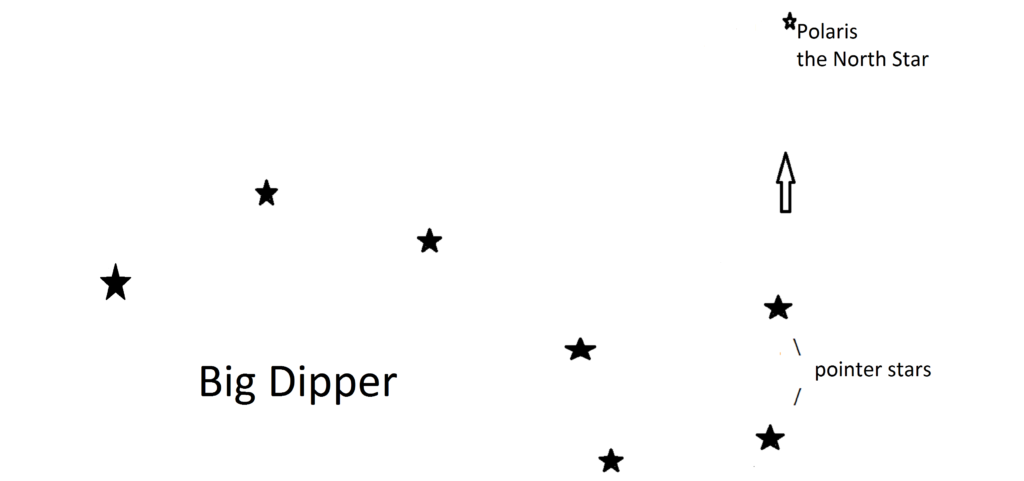The Night Sky: The Sky in December 2017
by Dee Sharples-
During the month of December, look toward the north to learn more about the night sky. Many people are familiar with Polaris, the North Star, but mistakenly believe it’s the brightest star in the sky. At magnitude 1.97 it’s not a very bright star at all and actually is only the 49th brightest star in the sky. You can find Polaris by facing due north and measuring up from the horizon about 40 degrees (4 fist widths). The Earth rotates on its axis at an angle of 23.5 degrees, and our North Pole points almost directly at Polaris. It doesn’t appear to move through our sky like all the other stars but instead seems to be fixed in the same position every night.
The Big Dipper can be used to help you find Polaris but at this time of year it’s very low in the sky in the early evening. You may not be able to see it unless you have an unobstructed northern horizon. As the Dipper revolves counter-clockwise around Polaris, it will be higher in the northeastern sky after midnight. Find the “pointer stars”, the two stars that form the outside edge of the cup of the dipper, and extend an imaginary line between these two stars about four times and it will bring you very close to Polaris.
But Polaris hasn’t always been the North Star. The Earth spins like a top and, like a top, it wobbles. This wobble is called “precession” and is caused by the gravitational pull of both the sun and the moon on our planet. As the Earth wobbles, the angle of its tilt changes from 22.1 — 24.5 degrees and back every 26,000 years. In the year 3,000 BC around the time the pyramids were being built in ancient Egypt, the Earth was tilted at a slightly different angle. Its axis pointed at a star named Thuban which served as the North Star until precession gradually changed the tilt of the Earth so our North Pole pointed toward Polaris. For more information about precession, check out this NASA link: https://starchild.gsfc.nasa.gov/docs/StarChild/questions/question64.html

A beautiful and easy to find northern constellation is Cassiopeia, the Queen. At the beginning of the month after it becomes fully dark, look high in the northeastern sky for a group of bright stars resembling the letter “M” standing on its side. As the night progresses Cassiopeia will move counter-clockwise to stand high above Polaris looking very much like a slightly distorted “M”. By the end of December, Cassiopeia will reach this position in the sky earlier, around 6:30 PM.
The full moon on December 3rd will be the largest in 2017. The moon follows an elliptical orbit as it revolves around our planet, and on the 3rd it will be at perigee, its closest approach to Earth at 222,135 miles. This is referred to as a “Super Moon” but in actuality it will be only 7% larger than average, a very small difference not noticeable by most people. Go outside at 8:00 PM to view this “Super Moon” rising in the east. It will appear huge, just like any other rising moon, and not because it’s closer to Earth. One theory is that a rising full moon appears huge because of an optical illusion. Seeing the moon rise above foreground objects, such as trees and buildings, tricks the brain into perceiving that it’s actually bigger. There’s a great explanation and simple experiments to test out this theory at http://www.unmuseum.org/exmoon.htm.
The Geminid meteor shower will peak in the early morning hours of December 14th. Around 2:00 AM, look high in the south for the constellation Gemini the Twins. Gemini is distinctive because of two bright stars, one above the other, representing the heads of the twin brothers Castor and Pollux. The meteors, which are pieces of debris left from a comet which had passed through our solar system, will appear to radiate from this constellation. If the sky is clear and dark, you can expect to see up to 120 meteors per hour. A few sporadic meteors from this shower can also be seen from December 4-17 but not nearly as many as at the peak.
This year the winter solstice occurs at 11:28 AM on December 21. On this shortest day of the year, there will be only 8 hours and 59 minutes of daylight, but after that you can look forward to the days getting longer, first by a few seconds then by a few minutes, every day.

Magnitude:
Measures the apparent brightness of a celestial object and is expressed by a decimal. The larger the number, the dimmer the object.
Sun: -26.7
Full Moon: -12.6
Venus at its brightest: -4.4
Bright star: 0.0
Dimmest star visible with the unaided eye: 6.0
How to measure degrees in the sky: A simple “ruler” is to hold your arm straight out and make a fist. The area of the sky covered by your fist measures roughly 10 degrees. By moving your fist and counting how many “fist widths” it takes to reach an object in the sky, you’ll have an approximation of degrees.
 Dee Sharples is an amateur astronomer who enjoys observing planets, star clusters and the Moon through her telescope. She is a member of ASRAS (Astronomy Section of the Rochester Academy of Science) and records “Dee’s Sky This Month”, describing what can be seen in the sky, on the ASRAS website at rochesterastronomy.org. Watch for her monthly Owl Light News feature to learn more about the night sky.
Dee Sharples is an amateur astronomer who enjoys observing planets, star clusters and the Moon through her telescope. She is a member of ASRAS (Astronomy Section of the Rochester Academy of Science) and records “Dee’s Sky This Month”, describing what can be seen in the sky, on the ASRAS website at rochesterastronomy.org. Watch for her monthly Owl Light News feature to learn more about the night sky.